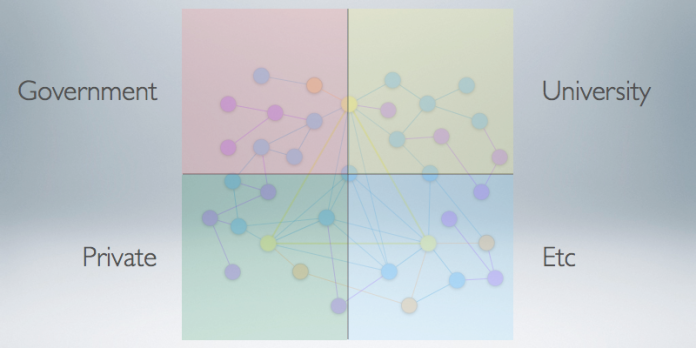When building the startup community here in Kelowna, I think it is important to remember that we are trying to build a network rather than a hierarchy. Networks are loose and informal, can be very inclusive, and most important are resilient. If a node or a few nodes on the network disappear, the network as a whole will remain.
Keeping in mind Brad Feld’s first rule of the Boulder thesis (that the startup community has to be entrepreneur led) I have spent some time thinking about what our network should look like (in an abstract way), and how it might evolve. Hopefully this gives us direction as to how we can start creating our own startup network.
Growing the Network
1) The core of the network is going to be the leaders. These are experienced entrepreneurs that are willing to put their name out and be visible leaders in the community. It is important to find a small number of these leaders and get them talking so they can set the tone for community as a whole. Over time these leaders may change, that is the nature of a network. But to get things rolling we need to find a core group willing to help out.
2) There are other experienced entrepreneurs that might want to get involved. In fact, I believe that there are many in our valley. However, they might not want to have their names out in the open. They value their privacy and are tired of being pitched all the time. They want to be involved, but need someone to run interference for them and only introduce those startups that are truly relevant to them. As their peers, the Leaders need to take this role. To get these experienced entrepreneurs engaged, they need to be able to connect to the network in a way that is comfortable for them. And who knows? Maybe in the future they will become Leaders. But for now, they need to be one step removed.
3) Next is the meat of the network: startups. They will be connected to everyone else in the network, but mostly, they should be connected to one another. They should know each other from working in the same spaces and from events. They should be connected to the Leaders quickly, and over time, to other experienced entrepreneurs.
4) Finally, the service providers. These are the accountants, lawyers, design agencies, government organizations, universities, brand consultants, etc. that help the startup ecosystem. They will have an assortment of possible connections.
This is how I envision the development of our startup network. Obviously, in real life things are more organic. Many sub-networks involving all of the above actors already exist, so our task will be to link these existing networks.
We need to connect everyone up into one massive network to gain the benefits of a startup community. One should be able to traverse from one side of the community to the other through the network connections. Remember “six degrees of separation”? Everyone should be connected to everyone else through the network, and I hope it would take less than six jumps.
It is also important to note that this is not a network map of the entire tech community in Kelowna. It is only the niche of startups, which will be connected obliquely to the wider tech community and all it’s other sub-communities such as the creative, animation and games communities.
Connecting Comfortably
The network as a whole will span many different communities. For example, if you divide the network into a few simple parts, you might find that some of the leaders, startups and service providers belong to government, academia, private industry, or other communities.
Currently in Kelowna we have built up a lot of inertia around a single community: government (in the form of Accelerate Okanagan). We need to expand the network to cover more communities. Not only for the sake of resilience of the network (eg. what happens if Accelerate Okanagan is no more?), but also to increase the number of ways new members to the network can connect comfortably.
In my next post I will talk about how we must increase the number of ways we engage with the community, in order to make it easier for people to engage in a manner of their choosing.




